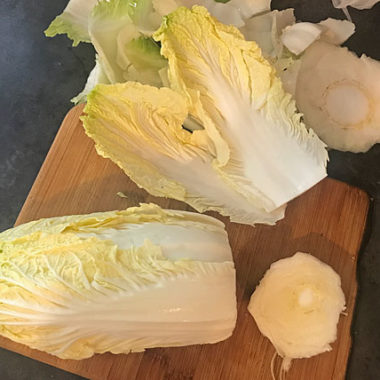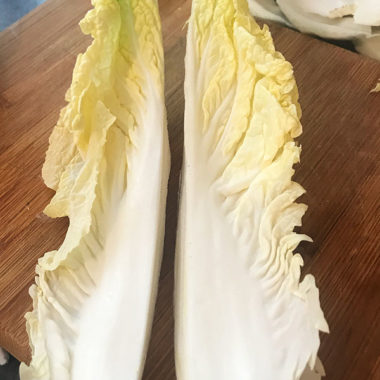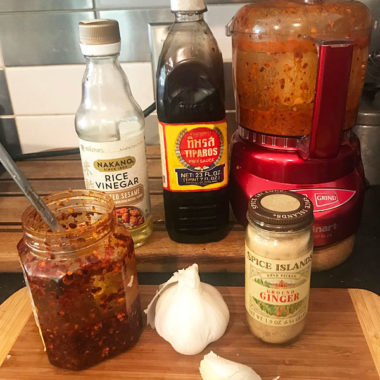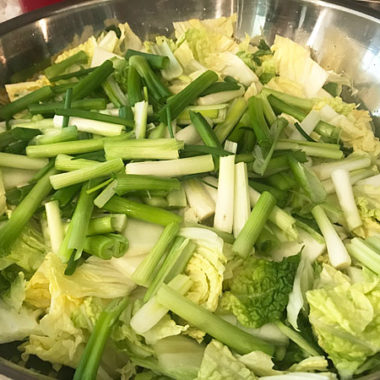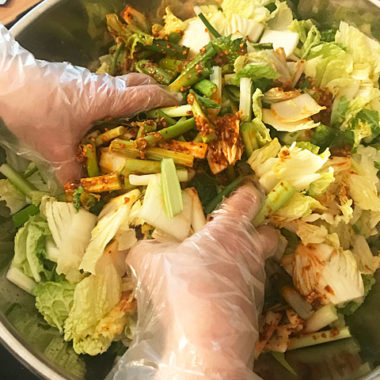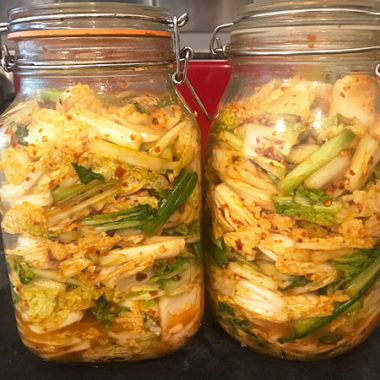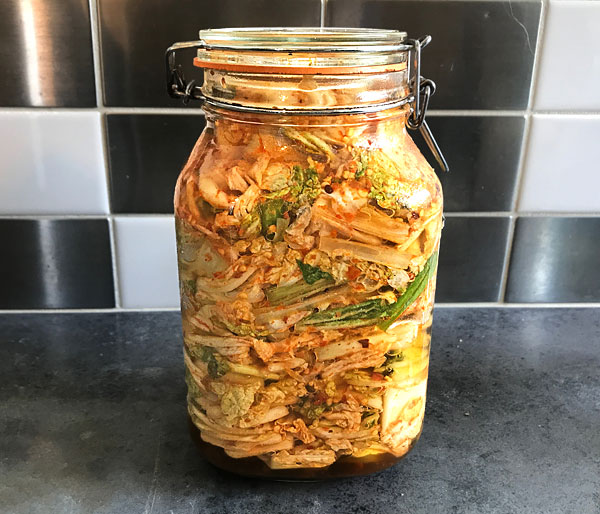
A cabbage kimchi recipe that provides plenty of kimchi for many weeks to come. Easy to make, lasts a long time in the refrigerator, and filled with spicy deliciousness.
*See Kitchen Notes for more information, substitutions and related links.
- 1 large head Napa Cabbage* (about 4 pounds)
- 1/2 cup salt (for initial brine)
- 2 bunches scallions (green onions)
- 1 cup water
- 4 - 6 cloves garlic*
- 2 Tbsp ground ginger
- 4 - 6 Tbsp Korean red chili Paste*
- 3 - 4 Tbsp fish sauce (not the sweet kind)
- 3 Tbsp rice vinegar
- 1 scallion, chopped (optional)
- 1 large bowl
- food processor or blender
- protective gloves
- 1-2 large jars or containers (non-corrosive, airtight and sterilized)
-
Cut the end of the cabbage about 1 inch from the bottom. This allows for easy disassembling and less cutting.
-
Rinse each leaf in cold water. You can fill a clean sink or large bowl and do this quickly.
-
Slice each leaf lengthwise down the center and chop into 1 inch pieces.
-
Put cabbage in a large bowl, sprinkle with the salt and toss with your hands, distributing the salt thoroughly.
-
Let cabbage sit for at least an hour while you prepare everything else.
-
In a blender or food processor, combine water, garlic, ginger, fish sauce, chile paste, rice vinegar and one chopped scallion (optional)
-
Blend until garlic is completely ground. Let rest for about 5 minutes. Taste and adjust to your liking if needed.
-
Chop the scallions (green onions) in 1 - 1.5 inch lengths, both the white and green parts.
-
Taste the cabbage. If it is too salty, then rinse lightly and drain well. Dry the cabbage to remove as much of the water as possible. You do not want the cabbage too wet because it will make the kimchi sauce too runny as it sits.
-
Add the scallions to the cabbage.
-
Wearing rubber gloves, pour the chili sauce over the cabbage and scallions and toss until each piece is well covered in sauce.
-
Pack firmly into large sterile, non-corrosive, airtight containers. Pour any of the remaining sauce over the jarred cabbage (or as much as you want).
-
Leave to ferment in a cool dark place for a day, then store in the back of the refrigerator for at least a week* before eating. (I prefer to let it rest for 2 weeks, but others in my family can't wait that long.)
-
If kept cold, this kimchi will last at least a year.
Napa Cabbage - This is the best cabbage to use for Kimchi. Because it comes in different sizes, you might need to adjust the amount of sauce based on the size of the cabbage. The amount of ingredients in this recipe's sauce is actually based on a HUGE cabbage (probably 5-6 pounds) that yielded 3/4 gallon of kimchi. Therefore, if you use a smaller cabbage (around 4 pounds), you might want to reduce the amount of sauce used. Just use your own judgement. Any leftover sauce can be refrigerator and used for other vegetables, OR you could reduce the amount of ingredients by 1/3.
Chili Paste - I prefer using a chili paste to chili flakes. To make your own paste, soak 1/4 cup of dried Korean chili flakes in 1/4 cup olive oil overnight. The flakes will re-hydrate forming a paste. Korean chili flakes are sometimes labeled Korean chili powder or gochugaru. If labeled "powder", check for the graininess. Most Korean chili powders are coarse and that's what you want.
Other vegetable for chili paste - This chili paste can also be used to make Kimchi with other vegetables such as daikon radish, carrots, bean sprouts and celery. I do not recommend mixing these vegetables with the cabbage since they age at different rates and do not keep for as long a period of time as the cabbage. Daikon, especially, has a shorter self-life and only holds up for a few weeks; therefore, it's best to ferment it by itself. When pickled it will smell awful, but taste great.
